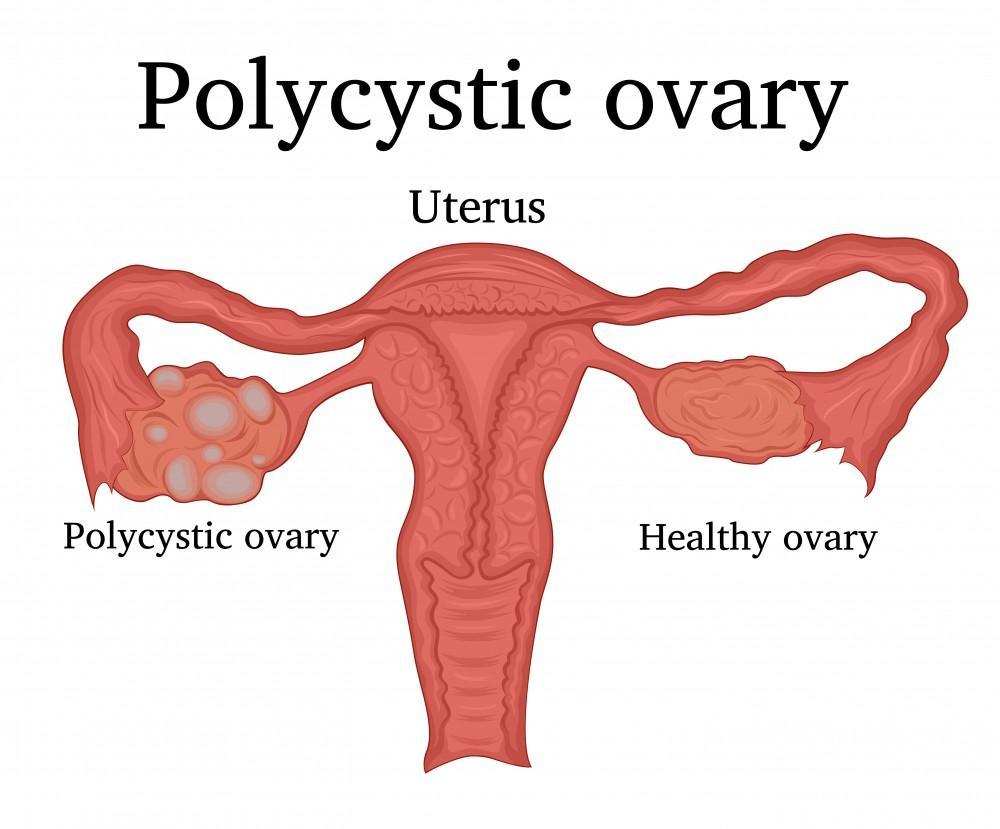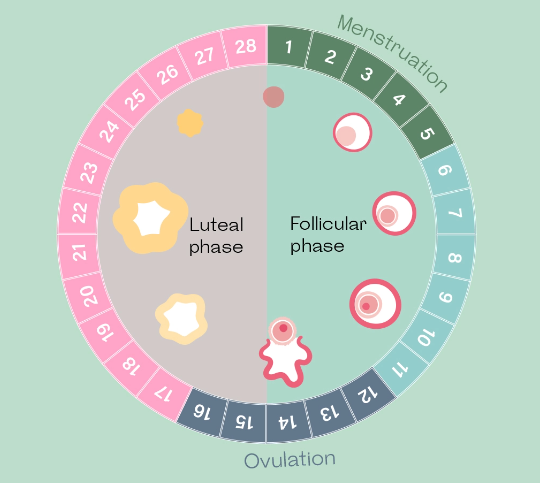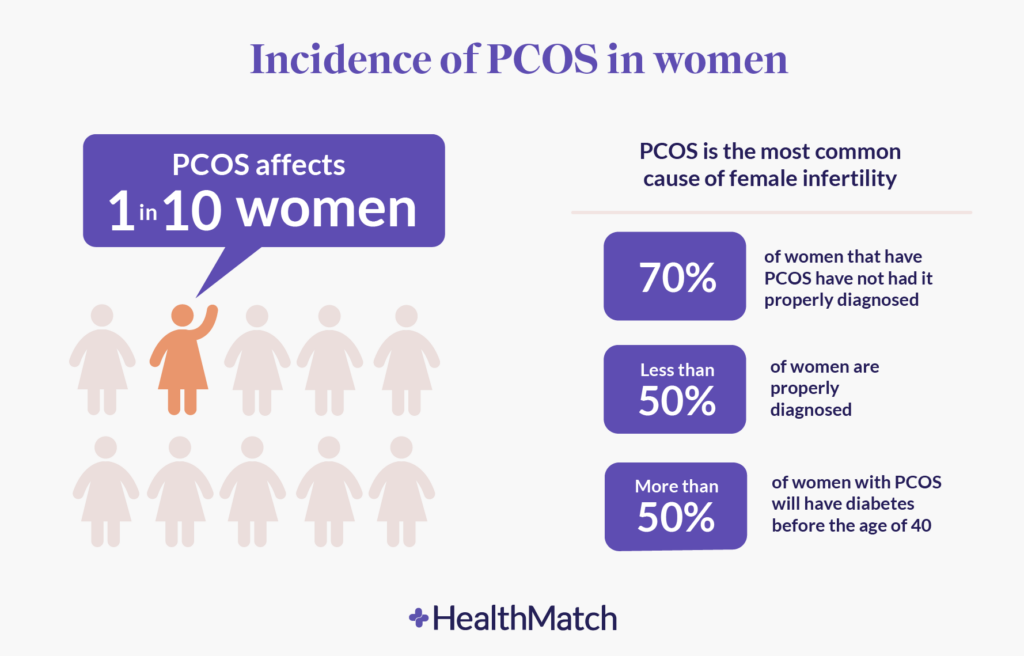Overview of the condition
What is PCOS?
Source: Birmingham and Women’s Hospital
According to the American College of Gynecology (ACOG), Polycystic Ovarian Syndrome is a disorder that is characterized by the body producing too much of the male reproductive hormone androgen, lack of a normal ovulation cycle, and cysts on the ovaries. The cause of PCOS is unknown, however, it may be related to multiple factors including insulin resistance, increased androgen levels, and irregular menstrual cycles.

Source: McDowell Mountain Gynecology Website
PCOS may also cause an abnormal ovulation cycle. During a normal menstrual cycle, eggs will mature in follicles in the ovaries during the follicular phase. The ripest egg is then released to one of your fallopian tubes, where sperm may meet the egg, which is called ovulation. If there is no sperm, then the unfertilized egg is released, along with the lining of the uterus, which is what causes bleeding, or your “period”. Then, the luteal phase begins where hormones are released to thicken the lining of the uterus to start over the cycle. The average menstrual cycle lasts 28 days, although slightly shorter or longer cycles are considered normal.
With PCOS, the polycystic ovaries may contain follicles with eggs, however, the follicles may not mature properly. This could cause a lack of ovulation or release of an egg, referred to as an ovulation. It is also possible that PCOS may cause late ovulation, causing missed or irregular periods. Many women may not even realize they have an abnormal menstrual cycle until trying to conceive, since hormonal contraception masks irregular or no periods.

Source: Mannat Fertility Clinic
It is thought that PCOS affects as many as 1 in 10 women, with up to 70% of women being undiagnosed. It is the leading cause of menstrual irregularity and infertility worldwide.

Source: Health Match Blog
Due to the difficulty in diagnosing the condition, the exact prevalence figures of PCOS are unclear
- One study found that the pooled mean prevalence across 27 surveys was 21.27%, finding that the number of women with the condition has increased over the last decade (Deswal et al., 2020).
- Before this publication, the prevalence of the disorder was cited between 2 and 26% worldwide.
- Major differences in these rates may be due to inconsistent and differentiated diagnostic criteria, sample heterogeneity, socioeconomic level, medical care access, risk factors, and health and education awareness.
- Race and ethnicity affect the clinical representation of PCOS to different genetic and environmental factors (Deswal et al., 2020).
- For example, in 2017 it was noted that Hispanic women with PCOS presented a higher degree of hyperandrogenism, and metabolic issues as compared to non-Hispanic women (Lawrence et al, 2017).
PCOS is very nuanced and can be experienced differently by different races and ethnicities, further complicating diagnosis.
Not all women will have all the symptoms of PCOS, which can make the condition difficult to diagnose.
However, there are a few telltale signs and symptoms:
- Infertility
- irregular or no periods
- Obesity – approximately 50% of women with PCOS are obese
- Excessive hair growth on the face, chest, abdomen, and upper thighs
- Severe acne and acne that occurs in adolescence and does not respond to treatment
- Oily skin
- Fluid-filled sacs on the ovaries (cysts)
- Patches of thick, darkened skin called acanthosis nigricans
- insulin resistance
- Type I diabetes
It is important to note that many women may not realize they have PCOS until they try to conceive, as many hormonal forms of contraception can mask some of these symptoms, such as irregular or no periods

Source: Nova IVF Website
The cause of PCOS is unknown, however, it is believed that the diagnosis may be related to many different factors working together, such as insulin resistance, high androgen levels, and irregular periods. It is also thought that some genes may be linked to PCOS, suggesting that it may be a hereditary condition.
Researchers are also investigating the link between weight gain and PCOS by studying the relationship between excess insulin production and symptoms associated with PCOS.
While there is no cure, there are many treatment options, and many women can lead a normal, healthy life!
One main goal for many women with PCOS is to maintain a healthy weight, as this can eliminate many of the symptoms, including irregular periods and acne. However, if symptoms are unmanaged, women with PCOS may face long-term risks, such as:
- Obesity that may lead to high blood pressure, cholesterol, and diabetes
- Emotional distress and depression, or other mental health concerns
- Fertility issues
- Endometrial hyperplasia (thickening of the uterine lining): while there is a low risk for this condition, in women with PCOS who are obese, diabetic, or have long-term menstrual irregularity, the risk is much higher.
However, with proper treatment and support, many women can healthily manage the condition and are also able to conceive a healthy baby with fertility treatments, especially if they are under 35 years of age.
- American College of Gynaecology (ACOG) Reports
- Fast Facts About Polycystic Ovary Syndrome (PCOS) – The Woman’s Clinic
- Deswal R, Narwal V, Dang A, Pundir CS. “The Prevalence of Polycystic Ovary Syndrome: A Brief Systematic Review.” J Hum Reprod Sci. 2020 Oct-Dec;13(4):261-271. doi: 10.4103/jhrs.JHRS_95_18. PubMed
- Eunice Kennedy Shriver National Institute of Child Health and Human Development – NICHD
- Lawrence E, Susan J, Fangbai S, Richard L, Alex P, Karl H, et al. “Racial and ethnic differences in the polycystic ovary syndrome (PCOS) metabolic phenotype.” Am J Obstet Gynecol. 2017;216:493.e1–13.
- Polycystic ovary syndrome (PCOS) – Mayo Clinic
- Pathophysiology & Clinical Presentation | Polycystic Ovarian Syndrome Case Study
- PCOS and fertility: everything you need to know – Tommy’s
- Polycystic ovarian syndrome (PCOS) program – Yale Medicine
- Rosenberg, S. L. “The relationship between PCOS and obesity: Which comes first?” Touro Scholar. Touro Scholar
